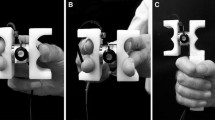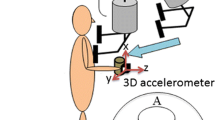Summary
A test object (grip apparatus) was held at its upper part using a precision grip. Small balls were dropped into a target cup at the bottom of the apparatus. The grip force, the load force (vertical lifting force) and the vertical movement were measured. Electromyographic activity (e.m.g.) was recorded from four antagonist pairs of hand/arm muscles primarily influencing the grip force or the load force. The balls were dropped either by the subject during a bimanual task, or unexpectedly by the experimenter. When the subject dropped the ball, preparatory actions occurred before the rapid increase in the vertical load caused by the impact. These actions appeared ca. 150 ms prior to the impact and involved a grip force increase and a lifting movement of the grip apparatus. The e.m.g. activity increased in all eight of the hand and arm muscles, indicating a general stiffening of the hand/arm system prior to the impact. Furthermore, the preparatory actions were programmed adequately for the size of the load force step at the impact, i.e. an adequate safety margin to prevent slips was preserved during the critical period of the impact. Thus, variations in this step caused by changes in (i) the weight of ball, (ii) the weight of the grip apparatus and (iii) the length of the drop were adequately taken into account during the programming of these actions. In addition, the frictional condition between the skin and the grip surface was also taken into account. The relevant sensory information apparently was obtained during the handling of the ball and the grip apparatus prior to the drop. There were also task-related automatic muscle responses triggered by the impact. These responses, which also served to stiffen the hand/arm system, were most pronounced during unexpected load changes, but they appeared too late to prevent slips. However, if no overall slip occurred, the triggered responses were functional in the sense that they helped to quickly restore the safety margin and the vertical position of the object.
Similar content being viewed by others
References
Belen'kii VY, Gurfinkel VS, Pal'tsev YI (1967) Elements of control of voluntary movements. Biofizika (Moskva) 12: 135–141
Bizzi E, Kalil R, Tagliasco V (1971) Eye-head coordination in monkeys: evidence for centrally patterned organization. Science 173: 452–454
Cole KJ, Abbs JH (1987) Kinematic and electromyographic responses to perturbation of a rapid grasp. J Neurophysiol 57 (in press)
Cole KJ, Gracco VL, Abbs JH (1984) Autogenic and nonautogenic sensorimotor actions in the control of multiarticulate hand movements. Exp Brain Res 56: 582–585
Cordo PJ, Nashner LM (1982) Properties of postural adjustments associated with rapid arm movements. J Neurophysiol 47: 287–302
Crago PE, Houk JC, Hasan Z (1976) Regulatory actions of human stretch reflex. J Neurophysiol 39: 925–935
Darton K, Lippold OCJ, Shahani M, Shahani U (1985) Longlatency spinal reflexes in humans. J Neurophysiol 53: 1604–1618
Day BL, Rothwell JC, Marsden CD (1983) Interaction between the long-latency stretch reflex and voluntary electromyographic activity prior to a rapid voluntary motor reaction. Brain Res 270: 55–62
Desmedt JE (ed) (1978) Cerebral motor control in man: long loop mechanisms, Vol 4. Karger, Basel
Dietz V, Noth J, Schmidtbleicher D (1981) Interaction between preactivity and stretch reflex in human triceps brachii during landing from forward falls. J Physiol (Lond) 311: 113–125
Dufresne JR, Gurfinkel VS, Soechting JF, Terzuolo CA (1978) Response to transient disturbances during intentional forearm flexion in man. Brain Res 150: 103–115
Forssberg H, Grillner S, Rossignol S (1975) Phasic dependent reflex reversal during walking in chronic spinal cats. Brain Res 85: 103–107
Forssberg H, Grillner S, Rossignol S (1977) Phasic gain control of reflexes from the dorsum of the paw during locomotion. Brain Res 132: 121–139
Gracco VL, Abbs JH (1985) Dynamic control of the perioral system during speech: kinematic analysis of autogenic and nonautogenic sensorimotor processes. J Neurophysiol 54: 418–432
Hammond PH (1956) The influences of prior instructions to the subject on an apparently involuntary neuro-muscular response. J Physiol (Lond) 132: 17P-18P
Hugon M, Massion J, Wiesendanger M (1982) Anticipatory postural changes induced by active unloading and comparison with passive unloading in man. Pflügers Arch 393: 292–296
Humphrey DR, Reed DJ (1983) Separate cortical system for control of joint movement and joint stiffness: reciprocal activation and coactivation of antagonist muscles. In: Desmedt JE (ed) Motor control mechanisms in health and disease. Raven Press, New York, pp 347–372
Johansson RS, Westling G (1984a) Influences of cutaneous sensory input on the motor coordination during precision manipulation. In: von Euler C, Franzen O, Lindblom U, Ottoson D (eds) Somatosensory mechanisms. Macmillan Press, London, pp 249–260
Johansson RS, Westling G (1984b) Roles of glabrous skin receptors and sensorimotor memory in automatic control of precision grip when lifting rougher or more slippery objects. Exp Brain Res 56: 550–564
Johansson RS, Westling G (1987) Signals in tactile afferents from the fingers eliciting adaptive motor responses during precision grip. Exp Brain Res 66: 141–154
Johansson RS, Westling G (1988) Coordinated isometric muscle commands adequately and erroneously programmed for the weight during lifting tasks with precision grip. Exp Brain Res 71: 59–71
Lacquaniti F, Soechting JF (1984) Behavior of the stretch reflex in a multi-jointed limb. Brain Res 311: 161–166
Lee RG, Murphy JT, Tatton WG (1983) Long-latency myotatic reflexes in man: mechanisms, functional significance, and changes in patients with Parkinson's disease or hemiplegia. In: Desmedt JE (ed) Motor control mechanisms in health and disease. Raven Press, New York, pp 489–508
Lee RG, Tatton WG (1975) Motor responses to sudden limb displacements in primates with specific CNS disorders and in human patients with motor system disorders. Can J Neurol Sci 2: 285–293
Marsden CD, Merton PA, Morton HB (1981) Human postural responses. Brain 104: 513–534
Marsden CD, Merton PA, Morton HB (1976) Servo action in the human thumb. J Physiol (Lond) 257: 1–44
Marsden CD, Rothwell JC, Day BL (1983) Long-latency automatic responses to muscle stretch in man: origin and function. In: Desmedt JE (ed) Motor control mechanisms in health and disease. Raven Press, New York, pp 509–539
McCloskey DI (1974) Muscular and cutaneous mechanisms in the estimation of the weights of grasped objects. Neuropsychologia 12: 513–520
McCloskey DI, Gandevia S, Potter ED, Colebatch SG (1983) Muscle sense and effort: motor commands and judgments about muscular contractions. In: Desmedt JE (ed) Motor control mechanisms in health and disease. Raven Press, New York, pp 151–168
Melvill-Jones G, Watt DGD (1971) Observations on the control of stepping and hopping movements in man. J Physiol (Lond) 219: 709–727
Morasso P, Bizzi E, Dichgans J (1973) Adjustments of saccade characteristics during head movements. Exp Brain Res 16: 492–500
Nashner LM, Cordo PJ (1981) Relation of automatic and postural responses and reaction-time voluntary movements of human leg muscles. Exp Brain Res 43: 395–405
Nashner LM, Woollacott M, Tuma G (1979) Organization of rapid responses to postural and locomotor-like perturbation of standing man. Exp Brain Res 36: 463–476
Phillips CG, Porter R (1977) Corticospinal neurones. Academic Press, London
Rothwell JC, Traub MM, Marsden CD (1982) Automatic and “voluntary” responses compensating for disturbances of human thumb movements. Brain Res 248: 33–41
Sherrington CS (1906) The integrative action of the nervous system, 2nd edn. Yale Univ Press, New Haven, CT
Traub JC, Rothwell JC, Marsden CD (1980) A grab reflex in the human hand. Brain 103: 869–884
Westling G, Johansson RS (1984) Factors influencing the force control during precision grip. Exp Brain Res 53: 277–284
Westling G, Johansson RS (1987) Responses in glabrous skin mechanoreceptors during precision grip in humans. Exp Brain Res 66: 128–140
Author information
Authors and Affiliations
Rights and permissions
About this article
Cite this article
Johansson, R.S., Westling, G. Programmed and triggered actions to rapid load changes during precision grip. Exp Brain Res 71, 72–86 (1988). https://doi.org/10.1007/BF00247523
Received:
Accepted:
Issue Date:
DOI: https://doi.org/10.1007/BF00247523




